
Physiotherapy
The following advice booklet will help you recover from your breast surgery and give you guidelines to help regain the full use of your arm(s) and resume normal activities.
The exercises and advice are given as a guide only. Each person is different and therefore will heal and progress at varying rates, as people may have different types of surgery and different post-op therapies. All have to be taken into consideration.
Deep breathing and circulation exercises
Immediately following any surgery and anaesthetic, it is important to take 3 deep breaths every 15 minutes.
Breathe in and out deeply, from the base of the lungs (feeling the ribcage expanding equally left and right) followed by two huffs, which consists of a forced breath out (as if steaming up a mirror) and then finally try a gentle cough. Also keeping ankles and wrists moving up and down to maintain circulation (every 30 minutes).
Day one
It is important to start gently moving your arm on the operated side from the first day following your operation to avoid developing a stiff shoulder.
It is recommended that you perform your exercises little and often, but do not tire yourself nor continue with any movement which is painful.
Circulation exercises
- Every half an hour carry out simple circulation exercises of the arms and shoulders. Start by making a fist and then releasing and straightening fingers (repeat 5 times).
- Then slowly move and circulate your wrists (about 5 times).
- Then bend and straighten your elbow (about 5 times)
Shoulder movement
Gently raise and lower your shoulders (5 times).
Gentle shoulder circling, can help to ease pain and tension by relaxing the muscles.
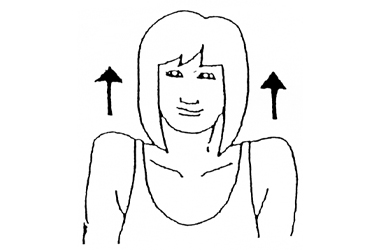
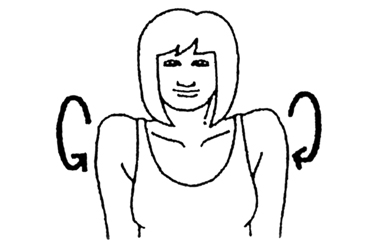
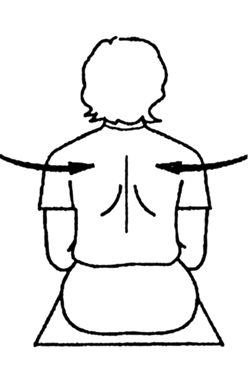
Posture correction
After your operation you may feel that you want to slouch. It is important that you try to sit up straight and gently draw your shoulder blades back towards each other.
It is best to sit in a supportive high backed chair, with perhaps a cushion behind your back to maintain a good posture.
Your arm and shoulder on your operated side are likely to feel stiff and sore for a few weeks, therefore you may wish to do your exercises, following some pain relief first. The exercises are very important to help your arm move freely and regain normal range of movement.
Set one exercises
These exercises should be done little and often, at least 4 times a day, for the first week after your surgery.
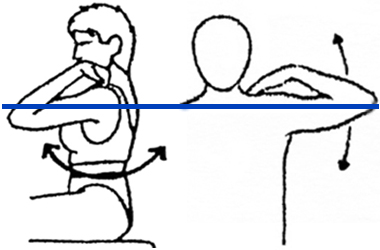
Sit upright with a good posture on the edge of the bed or on a chair and repeat each exercise 5 times.
- Keeping your elbow bent, raise your elbow forwards to the level of your shoulder or the point of discomfort and then slowly lower it down.
- Now raise your elbow to the side to the level of your shoulder or to the point of discomfort and then slowly lower it down.
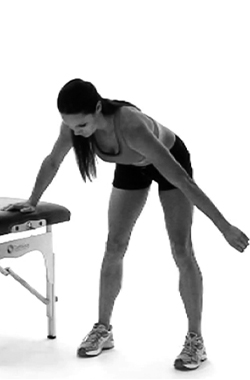
Pendular exercises
If you have a drain in, please make sure the bottle is secure in a drain bag or pocket, before starting this exercise.
These can be used to warm up when you begin the set two exercises or to relieve tense muscles and prevent stiffening up.
Support yourself using your hand on your un-operated side. Let your affected arm hang down and gently swing it backwards and forwards, side to side and in small circles.
Set two exercises
These can be started one week following surgery providing your drains have been removed.
They can be done in a sitting or standing position. Never push through pain – a gentle stretch sensation is normal.
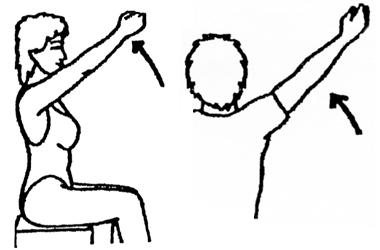
- Place your arm by your side with your elbow straight.
Raise your arm forwards and up above your head or to the point of discomfort. Then bring it slowly back down.
2. Raise your arm out to the side away from your body,
upwards and continuing up towards your head or to the
point of discomfort.
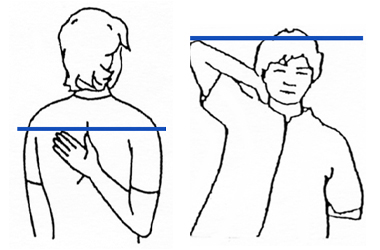
3. Slowly bring your arm down again.
Take your hand behind your back, reaching up between
your shoulder blades as far as possible.
4. Take your hand to the back of your neck and slide it
down your spine as far as is comfortable.
Further exercises at home
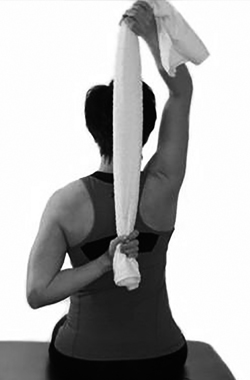
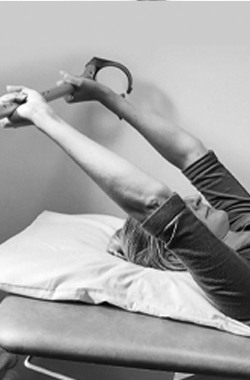
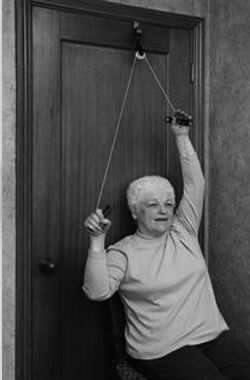
- Daily dry your back with a small towel, with one hand at the top pulling up and the other hand attached to the towel behind your back.
Repeat 5 times then reverse hands and repeat another 5 times. - Keep an umbrella or walking stick by your bed and every morning or night hold on to it with both hands whilst lying down and try to raise it above your head with straight arms, lowering it towards your pillow.
- Pulleys: Try creating a pulley system using a belt over a door hook and sit comfortably underneath. Let one arm gently pull down as the other goes up and vice versa.
Continue for 1 to 2 minutes once a day if possible.
Weekly measurements
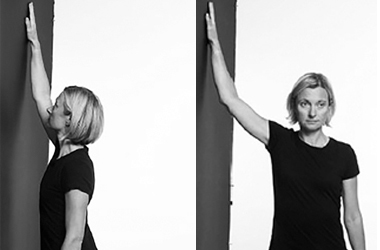
To monitor your progress, choose a door or wall and roughly measure how high you can walk your fingers up before discomfort.
- Stand facing the wall and walk your fingers up as high as possible.
- Then stand sideways and repeat.
Measure once a week and mark an ‘F’ for the forward movement and ‘S’ for the sideways movement.
Preparation for radiotherapy
If you are to have radiotherapy, this is the position you will need to achieve.
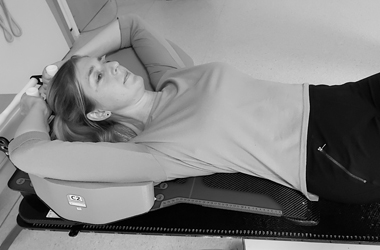
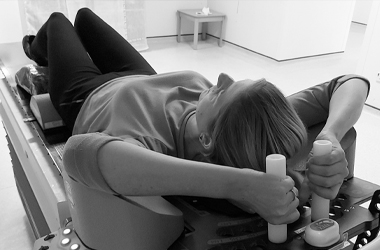
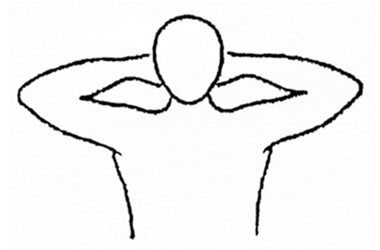
Practice this position in bed by tucking your hands under your head, bending your elbows and letting them relax out to the side.
As an alternative you can practice this in a sitting position by clasping your hands behind your neck keeping your head up.
Push your elbows backwards 5 times.
Continued exercises
Once you have achieved full range of movement, it is important to maintain it and keep the shoulder supple for about a year afterwards. If you are to have radiotherapy treatment, be aware that your muscles and surrounding tissue may tighten and become stiff, but keep gently persevering with the exercises on a daily basis.
Resuming normal activities
Try to use your arm on your operated side as normally and freely as possible. However, do not push through pain.
Gradually increase your daily activities as you feel able. Do not ‘guard’ or over-protect your arm as your muscles will become tense and your shoulder will stiffen up (putting you at risk of a frozen shoulder).
Lifting and housework
Only lift light objects, for example; half-filled kettle and perform light duties such as dusting, washing up, preparing light meals and hanging out light washing.
No hoovering, mopping or pushing a shopping trolley.
Use your good arm after two weeks as long as it does not pull on your operated side. After 4 to 6 weeks you can gradually start to increase the tasks you perform with your operated side within comfort.
Handbags and shopping bags
Avoid using a heavy handbag on your shoulder or a heavy shopping bag pulling your shoulder down, as this will compromise your circulation and cause muscle imbalance.
Driving
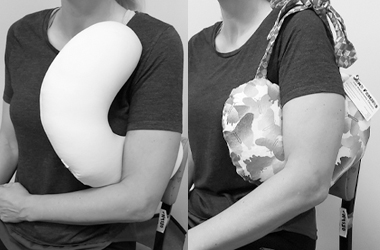
As a passenger you may need a soft cushion to pad underneath the seat belt if it crosses your operated side.
A cushion may also be useful to keep the weight and pressure of the arm away from the wound whilst resting and sleeping.
You should not drive for 4 to 6 weeks (depending on extent of surgery).
Check with your insurance company what their policy is. Only drive when you feel confident that you are safe, in full control of the car, can reverse and comfortably perform an emergency stop. Start with small distances on familiar roads.
Sport and leisure
Gentle swimming may be started between 4 to 6 weeks as long as the scar has healed well.
If you are having radiotherapy, ask your radiographer for advice about swimming, as it may differ in this case. Simple arm movements in water will promote drainage of fluid as well as support the weight of your arm in the water.
Non-contact and non-racquet sports may recommence at 6 to 8 weeks post-surgery.
Sports that require a lot of upper body and arm strength may need a graduated strengthening programme up to 12 weeks post-surgery before fully participating.
Prevention of lymphoedema
If you have had removal of lymph nodes or are to have radiotherapy following breast surgery, you are at risk of developing lymphoedema in the arm on the same side as the surgery. This arm becomes your ‘at risk’ arm and care must be taken for life.
Briefly explained, lymphoedema is ‘chronic swelling due to an impaired lymph drainage system, resulting in an increase in fluid accumulating in the tissues’.
For more information ask your breast care nurse or visit: www.lymphoedema.org/lsn.
Simple circulation exercises
Exercise plays a very important part in the prevention of lymphoedema as the stimulation of muscles helps promote drainage of fluid in the limb and improve joint mobility for example; Clenching and releasing your fist and bending then straightening your elbow should become a lifetime habit every half an hour.
Continue daily with the joint mobility exercises mentioned in this booklet, but avoid over-exertion during exercise.
Correct posture
Sitting upright is important as a poor, stooped posture with rounded shoulders will restrict drainage of fluid and increase muscle tension.
General care of the ‘at risk’ arm
As outlined by the lymphoedema support network leaflet, it is important to avoid any risk of lymphoedema in the operated arm.
Care and advice to reduce the risk of lymphoedema in the operated arm
- Never allow blood pressures, injections or blood samples to be taken from this arm.
- Keep skin supple with a daily moisturiser and avoid the skin becoming dry and flaky.
- Avoid cuts, scratches and bites. Therefore, wear gardening gloves, washing-up gloves and take care when cutting your nails.
- Avoid sunburn or overheating of the arm, for example, hot baths.
- Avoid restrictive jewellery and clothing.
Important
It is important to remember there is a lifetime risk of developing lymphoedema and so these need to become lifetime habits.
If you have any concerns or signs of swelling in your hand, arm or breast contact your breast care nurse or lymphoedema specialist immediately.
References
McNeely et al (2010) Cochrane review of Exercise interventions for Upper Limb Dysfunction due to breast cancer
The Lymphoedema Support Network leaflet: “Prevention of lymphoedema – A guide for Breast Cancer Patients”. www.lymphoedema.org/lsn.
J Todd et al: “A randomised controlled trial of two programmes of shoulder exercise following axillary node dissection for invasive breast cancer.” Physiotherapy vol 94 (2008) 265-273.
J Todd & A Topping (2004) “A survey of written information on the use of post-operative exercises after breast cancer surgery”. Physiotherapy vol 91 no.2 June 2005 pg 87-93.
Contact us
If you require further information please contact us on:
Telephone: 01642 854453
Email: [email protected]
Patient experience
South Tees Hospitals NHS Foundation Trust would like your feedback. If you wish to share your experience about your care and treatment or on behalf of a patient, please contact The Patient Experience Department who will advise you on how best to do this.
This service is based at The James Cook University Hospital but also covers the Friarage Hospital in Northallerton, our community hospitals and community health services.
To ensure we meet your communication needs please inform the Patient Experience Department of any special requirements, for example; braille or large print.
T: 01642 835964
E: [email protected]